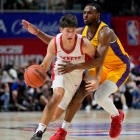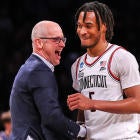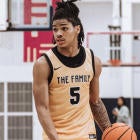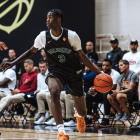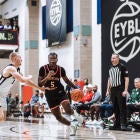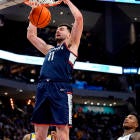 |
| Nate Wolters has become something of a cult figure in college hoops due to his game and small-school ties. (Getty Images) |
It's a Saturday afternoon in the middle of November and Nate Wolters is playing in an environment unbefitting of he and his team's talent. Hofstra's Mack Sports Complex provides a cushy, echoey amphitheater for the -- let's count them here -- 61 ticket-buying souls in attendance who can hear every shout, play-call, sneaker squeak and curse word barked in frustration following a foul. Wolters and upstart South Dakota State are here on Long Island in a nontelevised satellite mini-bracket of the 2K Sports Classic, while the major-conference teams (Alabama, Oregon State, Purdue, Villanova) got their runs in on ESPN2 at Madison Square Garden the two days prior.
SDSU's Saturday game happens to be against Marshall, so it's two effective mid-major teams with realistic NCAA hopes, even if those hopes rest on winning a conference tournament in a few months. But it's a good matchup, something of a BracketBusters-type tilt just before Thanksgiving. Behind Marshall's basket, about 10 rows up, an elderly man has fallen completely asleep, his baseball hat half off his head.
Not counted among the 61 attendees are the nearly 20 NBA scouts who have come out to see what all the fuss is about with this Wolters kid, who's become a revolution back home and inside the Summit League. And as his team gets going against the Thundering Herd, he's having a rough start. He finishes the first half shooting 2-for-10 and is largely unproductive against aggressive trapping schemes and extended perimeter pressing from Marshall's best player, DeAndre Kane. In the second half Wolters doesn't appear to be significantly more effective. Vocally, he's quiet, and outside of his yo-yo-like ball-handling ability (his most underrated skill), Wolters' game doesn't have flash embedded into it. It is deftly retro, featuring an arsenal of one-handed, running floaters; cool, step-back, mid-range jumpers; stop-and-go attacks to the lane and, most importantly, the ability to score, pass, rebound and defend at the most consistent of levels.
So we're closing in on the end here in Hempstead, N.Y. The Herd holds the lead for most of the second half, until Marshall guard Chris Martin misses a one-and-one free-throw attempt with 10.8 seconds remaining. Wolters grabs the rebound, hurries up the floor and …
… as you can see, immediately passes it off to teammate Chad White, who was wide open for the game-winning 3. Marshall didn't even get the chance to double Wolters before he was a step ahead, shooing the ball instead of shooting it. After a half-court heave from Kane doesn't fall, South Dakota State wins 78-77 in a game it had no business winning. In fact, the style of victory so terrifically mirrors how Wolters goes about his way on the floor.
Remember, he struggled, right? He didn't look good, and any casual fan watching would have been hard-pressed to point out who SDSU's best player was that day. If anything, Brayden Carlson, who made five 3s and finished with a game-high 23 points, looked to be the star. But by game's end, the quiet kid from St. Cloud, Minn., finished with 22 points, 10 assists, six rebounds, a steal and just one turnover. It is the prototypical Wolters Line. He quietly stuffs a stat sheet better than any player in college basketball. When asked how he played, Wolters responds, "Average at best." He's right -- this was his average, and the scouts in the seats aren't wowed. They're looking for something Jimmer-like.
But whatever you do, don't compare him Jimmer. Don't be that guy, because he is not that guy.
If you're unfamiliar with South Dakota State, that's no surprise. It's part of the team's and Wolters' charm. The school, located in Brookings, boasts 12,583 undergrads (the largest in the state) and one of the best monikers in hoops, the Jackrabbits. The school hasn't even been Division I for a decade. It made the leap from D-II in 2004 but didn't earn its eligibility for the NCAA tournament until the year before Wolters' freshman year, 2008-09, when it was initiated into the Summit League. Scott Nagy has coached the program for 18 years and won more than 300 games since he started there when he was 29 years old.
But the high times in D-II prompted the school to run for more money and make the big upgrade. That's when problems, stress and career doubt set in for the first time during Nagy's career. The program had so many things go wrong just before and during the transition. For a long stretch, it appeared to be the wrong call for the school.
"It was a train wreck, a disaster for three or four years," Nagy said.
The team left D-II without a conference to join. Recruiting was a nightmare. SDSU annually lost out on guys, talent-wise, who were at their level. And the guys they did get to campus left one or two years in because it was too hard. There was too much losing, an assault of single-digit-win seasons.
The team lost what Nagy described as the pre-Wolters best player in program history, Matt Jones, to chronic fatigue that caused him to prematurely end his basketball career. Eventually, Nagy had to completely redo his recruiting style and pitch. He was done with the fluff.
"I said, 'Don't come here if your gonna leave. I'm not interested in it. Division-I basketball is hard. People are telling you it's great all the time, but that's not what it is. It can be rewarding, but it's hard. And that's how I've recruited ever since. We will not baby you. It's just not what we do here. We've got Under Armour gear and a nice locker room and all that stuff. And that stuff lasts about three seconds, and then it comes down to who you spend your time with, and we have great kids."
If it weren't for two Kai Williams and Garrett Callahan, Nagy said the program would've perpetually still been tumbling. Who knows if he'd even still be there. Wolters almost definitely wouldn't.
 |
| Scott Nagy has spent nearly two decades guiding SDSU from D-II power to D-I doormat to the NCAA tourney. (US Presswire) |
Wolters initially leaned SDSU heading into his senior year of high school but, like almost all the others, backed off. He was hardly doing the decision-making then.
"I was … not happy," Nagy said. "We were just coming out of being a mess and his family wasn't sure if we were still a mess or not."
The family wanted to wait. Wolters, as easy-going as it comes, was fine with that. Nagy understood because the program had so much to prove: like whether it was even doing the right thing by chasing Division I glory. At the time, Wolters only had offers from three other schools, all of them D-II. On his end, there was no rush -- it was almost as if picking a school was like some big-school project. He procrastinated more than anything else.
"I didn't really even know what I was doing or even want to make a decision," Wolters said.
Nagy, who admits he was angry with the waffling, moved on. He was done with Wolters entirely. Assistant Austin Hansen was not. He attended high school games to see Wolters under the guise of scouting another player, and it took a while before Nagy caught on to what Hansen was doing. By March of Wolters' senior year, Nagy was back in, but now so were Colorado State and North Dakota State, who watched Wolters put up 25 points per game in the Minnesota state tournament.
To this day, Wolters says he can't recall what really made him decide to pick SDSU. He said it was probably because Colorado State was too far away and he didn't think North Dakota State truly wanted him. If there was a reason on SDSU's end, it was the selling point that's made him an NBA prospect: Nagy wanted Wolters as the point guard, the true point guard, the do-it-all point guard. Not a combo guy who sometimes is off the ball. From the minute he got on campus, Nagy gave him the green light. He didn't worry about Wolters making mistakes. He was their guy -- with all the freedom he wanted.
So started one of the most impressive turnarounds for a fertile D-I team in college basketball history.
Wolters is a frustrating interview because he's so casual, you'd think he was the distant cousin who visits occasionally and doesn't have much to say. The best way to describe him in two words would probably be "kind disinterest." The 21-year-old doesn't find himself to be worthy of attention and he doesn't talk unless asked a question. He almost never gets animated on the floor, and his inability to be a vocal presence has been a situation that SDSU coaches have worked around.
It's not natural for a point guard to be so reserved, but Wolters' casual demeanor can't be masked, and so his incredibly efficient play has been the proxy for verbal animation. Rarely can this be reliable in basketball, but it's worked over the past three and a half years at this program.
"He's not a rah-rah guy and I don't want him to be and people wouldn't believe it if he tried to be," Nagy said.
 |
| Wolters is quiet on and off the floor but one of the most fascinating players to watch in the sport. (US Presswire) |
"In warm-ups, when you see him walk out there, that's just him," Hansen said. "In the preseason, the coaches and I kinda gathered around him and said, 'You know, Nate, you're getting a lot of attention out there.' And we mention the NBA stuff, and he just goes, 'Yep, that's what I hear.'"
Wolters said he didn't even realize there were scouts interested enough to trek out to Hofstra to watch him play. His reaction to the news was like, "Really? That's cool to know. Hey, is there any pizza left?"
He is currently projected as a second-round pick by a number of respected draft analysts. His humble, quiet outlook could actually benefit him in an era when arrogance, entitlement and machismo peppers every draft class. Skill-wise, Wolters is deceptively quick and natural-born scorer (not a shooter). Should he go on to lead or be near the top of the nation in points per game this season -- a definite possibility -- God save us all from the Jimmer Fredette comparisons. White guard playing in/near the Mountain Time Zone who can put up 25. That's about where the similarities end.
Wolters can run an offense, where Jimmer didn't. Wolters can play D, where Jimmer couldn't. Wolters can tilt a defense like a wooden marble maze thanks to his threat and ability to make shots from 23 feet and in. (Watch the tape of him against Washington last season.) He also altered his shooting form by dropping his left thumb from the ball in the offseason. From 15 feet and in, his shot always had smooth spin. The coaches saw it. From deep? It was an awkward release and tilted rotation. No more.
He is the player everyone keys to stop, but is not able to, not even the big boys, and that's not something commonly found against small-league superstars. Against Alabama on the road, he put up 30 in the Jackrabbits' season-opening, last-second 70-67 loss. In his 11 career games against major-conference teams, Wolters is averaging 19.4 points, 5.1 assists, 4.4 rebounds and 1.6 steals per game in, playing 36 minutes or more in every game since he was a sophomore.
"There's never been a time where I've told Nate not to shoot," Nagy said.
SDSU is now on the map, picked to win the Summit League a year after it made the NCAAs, a first for the school and the state. No team from South Dakota had ever reached the tournament before Wolters took the Jackrabbits there.
The tests and attention from opponents are only about to get more trying. SDSU has a rough go of it, with road games against four realistic 2013 tournament teams: Minnesota, Montana, Belmont, New Mexico. If it gets two wins, that will be great for the program as a statement, but garnering an at-large bid this year will be near-impossible unless it comes out of that trek undefeated -- and then it will need to avoid losing all but maybe two games in Summit League play.
The best and worst thing about and for Wolters is his team's lack of TV time. It makes him tougher to judge, yet grows his myth even more when you can check the stat line and see the damage done. It's an odd thing, how not seeing him play can help you appreciate him even more.
With Wolters, the program might not have a voice, but it definitely has a face, a form and a formidable future.










